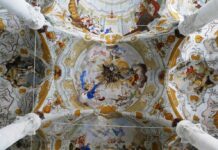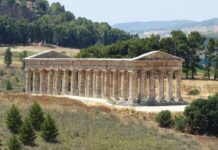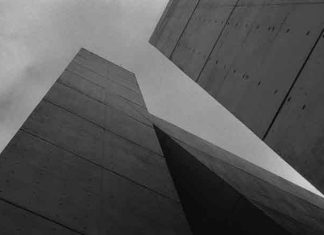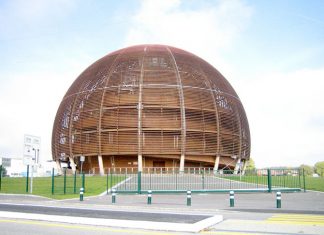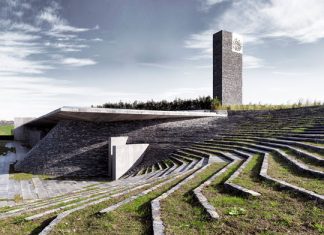| Architect: Emperor Hadrian & Apollodorus of Damascus |
| Location: Rome, Italy |
| Construction year: 118-125 AD |
| Structure material: Concrete |
| Architectural style: Ancient Roman architecture |
The Pantheon, constructed during the reign of Emperor Hadrian in the 2nd century AD, has tremendous historical significance. It was initially built as a temple dedicated to all Roman gods, but it has served various purposes by undergoing many function changes. Today, it stands as a symbol of Rome’s rich cultural heritage and architectural brilliance.
Many buildings have been built throughout history, but most of them don’t remain. Some of them changed the course of history. They did this with their architecture, with the importance attributed to them, or their witness to history.
All these structures had great effects. Architecture is a field for reflection of human desires and thoughts, wishes, or passions just like other branches of art. However, it is a field of art that is much more influential and has visible touches on human life.
The architecture of the Pantheon in ancient Rome was a good example of this impact. It has made the building one of the symbolic structures of absolute power and divine devotion.
Just like Hagia Sophia, the Pantheon building, which has maintained its influence and existence for ages and has served as a sacred temple for societies, is the most technological structure of its period.
In the next sections, we’ll talk about the historical background and architectural design of the Pantheon. We will also focus on its famous dome in detail.
The History of Pantheon Architecture
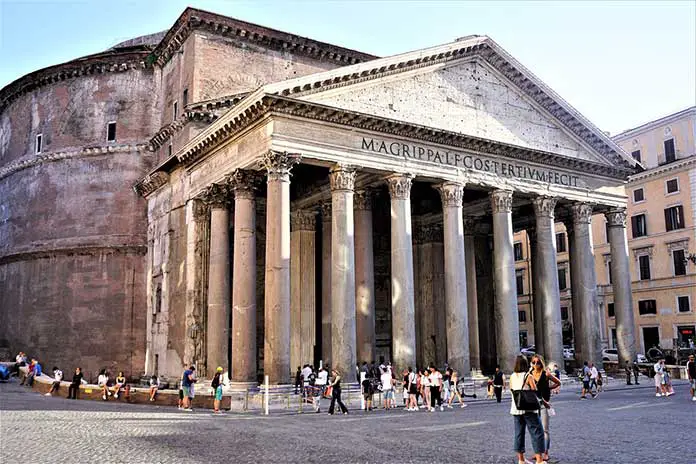
A temple was commissioned by Marcus Agrippa in Rome in 27 BC. It had the typical features of a rectangular-planned Greek temple. It was also smaller than Pantheon.
When this temple was destroyed, Emperor Hadrian had the Pantheon Temple built in 118 AD, which is still standing today. This architectural marvel has captured the imaginations of people worldwide for centuries.
Pantheon was probably built in the most glorious period of Rome. Hadrian is famous for building the largest and mightiest constructions of the ancient Roman architecture era.
He built huge baths, amphitheaters, triumphal arches and temples to spread his glory and power to wide geographies. The Pantheon, on the other hand, is a product of Hadrian’s passion for the field of religious structure.
Earlier temples were often built dedicated to a god or goddess. For instance, the Parthenon of Athens or the Temple of Zeus is one of them. However, the Pantheon was dedicated to all gods believed in Rome.
As its very name signifies, Pan(All)-theon(god) in Greek means “Temple of All Gods”. An ordinary temple should not have been built for such a great honor.
After the Romans accepted Christianity, some old pagan temples were converted into churches. The Pantheon of Rome got its share from this transformation in the 7th century under the name of Santa Maria Rotonda.
Due to this function change, a bell tower was added to each side of the triangular pediment of the building. However, these towers do not exist today.
It also became a burial place for esteemed individuals, including Italian kings and artists like Raphael. Today, it is one of the most famous buildings in Rome and among the most visited attraction points in the world.
Analysis of Pantheon Architecture
The Pantheon’s architectural design is a thumbnail of the creativity and engineering prowess of the ancient Romans. Its exterior and interior components have captivated visitors for centuries.
We’ll analyze the Pantheon architecture in two sub-titles, one is for exterior architecture and other for the interior architecture.
A. Exterior Architecture
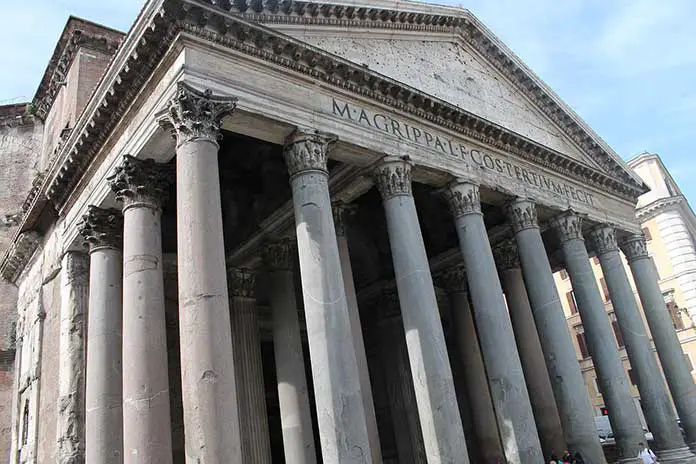
Pantheon includes several remarkable elements, especially on the exterior. At the front facade, there is a grand temple-like entrance and a magnificent porch, including Corinthian columns made of a single piece of marble.
These smooth Corinthian columns are arranged in 3 rows in the entrance part of the Parthenon. While the outermost row has 8 columns, there are 4 columns in the back two rows. Above these columns, there is a triangular pediment.
This grandeur entrance is coherent with the building’s iconic dome. The hemispheric dome is a remarkable engineering feat in Western architecture. It was constructed using concrete and some additional lightweight materials.
The Pantheon Temple is the oldest Roman building whose dome was built with concrete and has been preserved to nowadays.
The biggest reason why it has remained intact for so long is that it has been in continuous use throughout history and has undergone renovations and restorations.
B. Interior Architecture
The interior design of the Pantheon includes awe-inspiring decorations and ornaments. Its most striking feature is the oculus, a circular opening at the top of the dome. It serves both functional and symbolic purposes.
The oculus allows natural light to flood the main hall. This natural light creates an ethereal atmosphere. This hole is 6 meters in diameter. If we look up, we encounter a dizzying ceiling beauty accompanied by the light leaking through the hole.
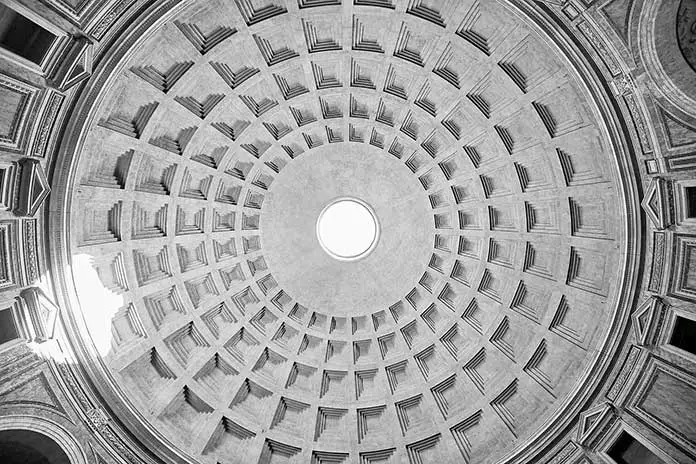
The interior of the structure revolves around the central rotunda. Thanks to the engineering brilliance and the extraordinary use of concrete, architects managed to create such a large, open space.
When you enter the structure, you will be amazed by the awe-inspiring decorative elements from several renowned artists and sculptors.
Intricate friezes, pediments and sculptures that adorn the walls showcase the craftmanship and artistic talent of ancient Roman artisans.
These ornate details add to the overall aesthetic appeal of the structure and transform it into a visual masterpiece.
The inner surface of the huge dome of the Pantheon has embedded square patterns. These patterns are similar to today’s cassette ceilings.
Inside, there are also burial places of some elite people in Rome, including the tomb of Raphael, the famous Renaissance architect.
The architectural design of the Pantheon still continues to inspire architects and designers after many centuries. Its ingenious use of materials, innovative engineering techniques and harmonious proportions have left an unforgettable mark on the world of architecture.
By examining the Pantheon’s architectural design, we acquire a deeper appreciation for the ancient Roman civilization and its outstanding achievements in building enduring structures.
The Pantheon Dome
Pantheon has incredible components that we should see, but its dome is a unique architectural piece in every manner. It’s the largest un-reinforced concrete dome in the world.
Until the 55.6-meter-high dome of Hagia Sophia was built, the highest dome belonged to the Pantheon. Additionally, it is one of the oldest domes in the world.
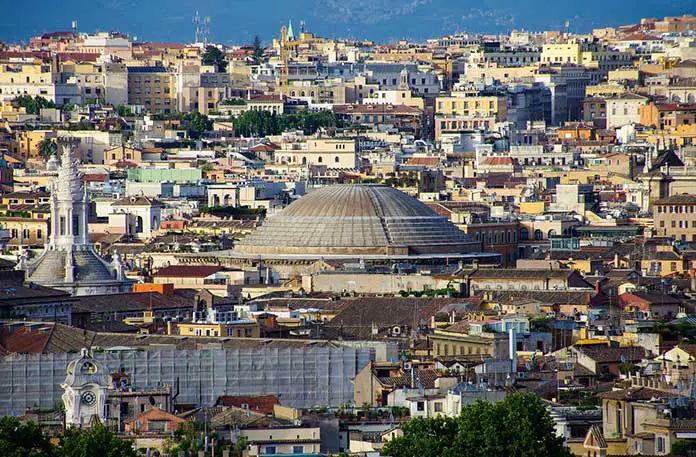
It is possible to place a sphere in contact with the floor, “the Oculus” and the side walls in the interior of the Pantheon, which has a central plan. Because the height of the dome from the ground and the inner width of the body part are equal to 43 meters.
In order to carry the 43-meter-diameter dome, the Romans applied the concrete with a special technique. According to this, as it goes up to the top of the Pantheon dome, the aggregate mix in the concrete gets lighter.
In this way, the unit weight of the concrete, which is the essential material of the dome, was at the lowest level near the oculus (Wilkinson).
Final Thoughts About Pantheon
In conclusion, the Pantheon is one of the most remarkable buildings in Rome. It demonstrates the architectural brilliance and the most advanced engineering technologies of the period it was built.
Its historical significance, coupled with its mesmerizing design, has attracted visitors from around the world for centuries. The edifice also has a deep historical background that sheds light on its evolution and purpose.
From its origins as a temple dedicated to the Roman gods to its transformation into a church and a burial place, the Pantheon has adapted to the changing times, preserving its cultural and architectural matter.
The Pantheon is also one of the most imitated and taken as reference architectural structures in history. For instance, the University of Virginia Thomas Jefferson Library, the Washington National Gallery of Art and the Villa Rotunda have domes that are imitated the Dome of Pantheon.
The architectural design of the Pantheon is a true marvel. Its exterior features, such as the grand entrance, porch, and iconic dome, showcase the ingenuity of the ancient Roman architects.
Visiting Pantheon is a big chance to witness firsthand the architectural brilliance of the past. So, if you have the opportunity to explore Rome, make sure to get inside this magnificent structure.
Thanks for reading this article about the Pantheon building in Rome. Hope you liked this amazing structure. Don’t hesitate to share this article with others!
FAQ
A: The word “Pantheon” comes from the Greek language and translates to “all the gods.” This name reflects the original purpose of the temple dedicated to all the Roman gods.
A: The building was constructed during the sovereignty of Emperor Hadrian in the 2nd century AD. The exact date of its completion is believed to be around 125 AD.
A: It is located in Rome, Italy. It stands in the historic center of the city, the Campus Martius.
A: While the building is no longer used as a place of worship, it remains a tourist attraction and is occasionally used for special events and ceremonies.
A: It’s primarily known for its exceptional architectural design. It is recognized for its massive dome, innovative use of materials like concrete, and the impressive oculus that allows light to enter the interior.
A: The oculus has both functional and symbolic purposes. Functionally, it allows natural light to enter the interior. Symbolically, it represents the connection between the earthly and divine realms.
A: No, entry to the Pantheon is free of charge for visitors. However, please note that there might be specific guidelines and restrictions for entry during certain times or events.




